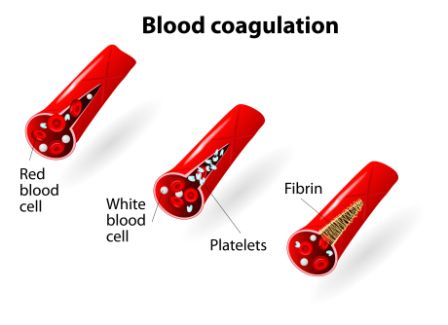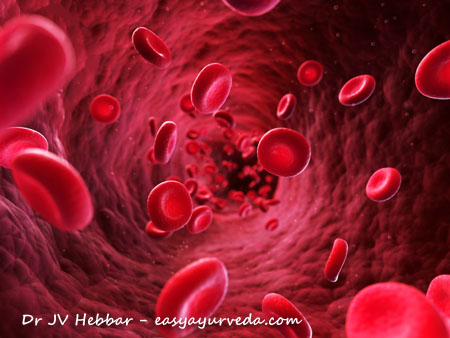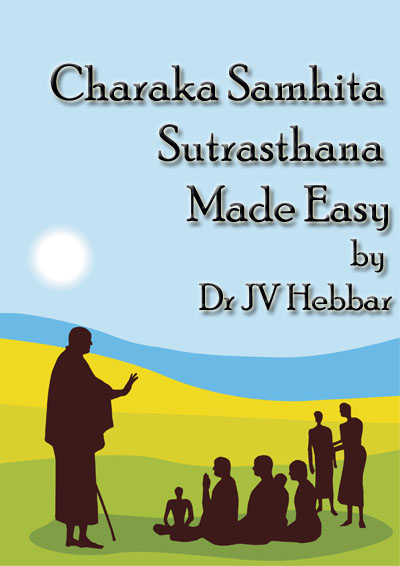Charaka Raktapitta Nidana: 2nd Chapter
The 2nd chapter of Charaka Samhita Nidana Sthana is called Raktapitta Nidana. It deals with causes, pathology, types and symptoms of Rakthapitta as per Ayurveda.
अथातो रक्तपित्त निदानं व्याख्यास्यामः||१||
इति ह स्माह भगवानात्रेयः||२||
athāto raktapitta nidānaṃ vyākhyāsyāmaḥ||1||
iti ha smāha bhagavānātreyaḥ||2||
We shall now explore the chapter on the “diagnosis of raktapitta” (a disease characterized by bleeding from various parts of the body). Thus said Lord Atreya [1-2]

Table of Contents
Pathology
Pathology responsible for Rakthapitta:
पित्तं यथाभूतं लोहित पित्तमिति सञ्ज्ञां लभते, तद् व्याख्यास्यामः||३||
pittaṃ yathābhūtaṃ lohita pittamiti sañjñāṃ labhate, tad vyākhyāsyāmaḥ||3||
We shall now explain the pathological changes of Pitta in the manifestation of raktha pitta [3]
Nidana, Samprapti
Raktapitta Nidana and Samprapti:
यदा जन्तुर्यव कोद्दालक कोरदूष प्रायाण्यन्नानि भुङ्क्ते, भृशोष्ण तीक्ष्णमपि चान्यदन्नजातं निष्पाव माष कुलत्थ सूप क्षारोपसंहितं, दधि दधिमण्डोदश्वित्कट्वराम्ल काञ्जिकोपसेकं वा, वाराह माहिषाविक मात्स्य गव्य पिशितं, पिण्याक पिण्डालु शुष्क शाकोपहितं, मूलक सर्षप लशुन करञ्ज शिग्रु मधुशिग्रु(खडयूष) भूस्तृण सुमुख सुरस कुठेरक गण्डीरकालमालकपर्णास क्षवक फणिज्झकोपदंशं, सुरा सौवीर तुषोदक मैरेय मेदक मधूलक शुक्त कुवल बदराम्ल प्रायानुपानं वा, पिष्टान्नोत्तरभूयिष्ठम्; उष्णाभितप्तो वाऽतिमात्रमतिवेलं वाऽऽमं पयः पिबति, पयसा समश्नाति रौहिणीकं, काण कपोतं वा सर्षप तैल क्षार सिद्धं, कुलत्थ पिण्याक जाम्ब वलकुचपक्वैः शौक्तिकैर्वा सह क्षीरं पिबत्युष्णाभितप्तः; तस्यैवमाचरतः पित्तं प्रकोपमापद्यते, लोहितं चस्वप्रमाणमतिवर्तते|
तस्मिन् प्रमाणातिवृत्ते पित्तं प्रकुपितं शरीरमनुसर्पद्यदेव यकृत्प्लीह प्रभवाणां लोहितवहानां च स्रोतसां लोहिताभिष्यन्दगुरूणि मुखान्यासाद्य प्रतिरुन्ध्यात् तदेव लोहितं दूषयति||४||
yadā janturyava koddālaka koradūṣa prāyāṇyannāni bhuṅkte, bhṛśoṣṇa tīkṣṇamapi cānyadannajātaṃ niṣpāva māṣa kulattha sūpa kṣāropasaṃhitaṃ, dadhi dadhimaṇḍodaśvitkaṭvarāmla kāñjikopasekaṃ vā, vārāha māhiṣāvika mātsya gavya piśitaṃ, piṇyāka piṇḍālu śuṣka śākopahitaṃ, mūlaka sarṣapa laśuna karañja śigru madhuśigru(khaḍayūṣa) bhūstṛṇa sumukha surasa kuṭheraka gaṇḍīrakālamālakaparṇāsa kṣavaka phaṇijjhakopadaṃśaṃ, surā sauvīra tuṣodaka maireya medaka madhūlaka śukta kuvala badarāmla prāyānupānaṃ vā, piṣṭānnottarabhūyiṣṭham; uṣṇābhitapto vā’timātramativelaṃ vā”maṃ payaḥ pibati, payasā samaśnāti rauhiṇīkaṃ, kāṇa kapotaṃ vā sarṣapa taila kṣāra siddhaṃ, kulattha piṇyāka jāmba valakucapakvaiḥ śauktikairvā saha kṣīraṃ pibatyuṣṇābhitaptaḥ; tasyaivamācarataḥ pittaṃ prakopamāpadyate, lohitaṃ casvapramāṇamativartate|
tasmin pramāṇātivṛtte pittaṃ prakupitaṃ śarīramanusarpadyadeva yakṛtplīha prabhavāṇāṃ lohitavahānāṃ ca srotasāṃ lohitābhiṣyandagurūṇi mukhānyāsādya pratirundhyāt tadeva lohitaṃ dūṣayati||4||

Causes and pathogenesis of Rakthapitta:
Pitta gets aggravated and Rakta (blood) exceeds its normal quantity due to the following:
Intake of food mostly containing yavaka (a take of hordeum vulgare linn).
Uddalaka and koradusa (paspalum scrobiculalum linn) and such other food products as par excessively hot and sharp along with
foods like nispava (a type of dolichos trilobus linn),masha (phaseolus rasiatus linn),
Kulattha – horsegram and alkalies or mixed with curd, whey,
udasvit (a mixture of water and butter milk in equal quantity), katvara (sour butter milk) and sour congee:
vārāha māhiṣāvika mātsya gavya piśitaṃ – Intake of the meat of pig, buffalo, sheep, fish and cow, mixed with oil cake,
piṇyāka piṇḍālu śuṣka śākopahitaṃ – pindalu (a tuber), dry vegetable or
– taking radish, mustard, garlic, karanja (pongamia pinnata),
sigru (moringa oleifera lam), madhusigru (a type of moringa oleifera lam), khabadayusa (vide commentary), bhustrna (cymbopogom citratuus stapf), varieties of basil, viz sumukha, sarosa, kutheraka gandiraka, alamala, parnasa, phanijjhaka or
followed by sura, sauvira, tusodaka, maireya, madhulaka and sukta types of wine, sour preparations of kuvala (zizyphus sativa gaertn) and badara (zizyphus jujube)
piṣṭānnottarabhūyiṣṭham – Intake of pastries in excess after food.
Frequent intake of un-boiled milk in excess while exposed to heat.
payasā samaśnāti rauhiṇīkaṃ – Intake of vegetable of rohinika (picroniza kurroa royle ex benth) with milk.
kāṇa kapotaṃ vā sarṣapa taila kṣāra siddhaṃ – Intake of small pigeon boiled with mustard oil or alkalies and
Intake of milk with kulattha (dolichos biflorus linn) oil cake ripe fruit of jambu (syzygium cumin skeels) lakuca (artocatpus lakoocha roxb). Or badara (zizyphus jujube) while exposed to heat.
Raktapit Samprapti:
When the rakta exceeds its normal quantity, it results in the opening of the entrances of channels of circulation which originate from spleen and liver. The aggravated fraction of pitta enters into these channels while circulating in the body and obstructs them resulting in the vitiation of blood. [4]
Definition
Definitions of Raktapitta:
संसर्गाल्लोहित प्रदूषणाल्लोहित गन्धवर्णानुविधानाच्च पित्तं लोहित पित्तमित्याचक्षते||५||
saṃsargāllohita pradūṣaṇāllohita gandhavarṇānuvidhānācca pittaṃ lohita pittamityācakṣate||5||
The disease is called raktha pitta because it come into contact with and vitiates rakta and also because it acquires the smell and color of the latter. [5]
Purvaroopa
Raktapitta – Poorvaroopa –
तस्येमानि पूर्वरूपाणि भवन्ति; तद्यथा- अनन्नाभिलाषः, भुक्तस्य विदाहः, शुक्ताम्ल गन्ध रस उद्गारः, छर्देरभीक्ष्णमागमनं, छर्दितस्य बीभत्सता, स्वरभेदो, गात्राणां सदनं, परिदाहः, मुखाद्धूमागम इव, लोह लोहित मत्स्यामगन्धित्वमिव चास्यस्य, रक्त हरित हारिद्रत्वमङ्गाव यव शकृन्मूत्रस्वेद लाला सिङ्घाणकास्य कर्ण मल पिडकोलिका पिडकानाम् , अङ्गवेदना, लोहित नील पीत श्यावानामर्चिष्मतां च रूपाणां स्वप्ने दर्शनमभीक्ष्णमिति (लोहितपित्तपूर्वरूपाणि भवन्ति)||६||
tasyemāni pūrvarūpāṇi bhavanti; tadyathā- anannābhilāṣaḥ, bhuktasya vidāhaḥ, śuktāmla gandha rasa udgāraḥ, charderabhīkṣṇamāgamanaṃ, charditasya bībhatsatā, svarabhedo, gātrāṇāṃ sadanaṃ, paridāhaḥ, mukhāddhūmāgama iva, loha lohita matsyāmagandhitvamiva cāsyasya, rakta harita hāridratvamaṅgāva yava śakṛnmūtrasveda lālā siṅghāṇakāsya karṇa mala piḍakolikā piḍakānām, aṅgavedanā, lohita nīla pīta śyāvānāmarciṣmatāṃ ca rūpāṇāṃ svapne darśanamabhīkṣṇamiti (lohitapittapūrvarūpāṇi bhavanti)||6||
Premonitory symptoms of Raktapitta are:
Anannābhilāṣaḥ – loss of appetite
Bhuktasya vidāhaḥ – improper digestion of food resulting in the burning sensation in chest
Shuktāmla gandha rasa udgāraḥ – eructation having sour taste and smell like vinegar
Charderabhīkṣṇamāgamanaṃ – frequent urge for vomiting
Charditasya bībhatsatā – discoloration and foul smell of vomited material
Svarabhedo – hoarseness of voice
Gātrāṇāṃ sadanaṃ – prostration of the body
Mukhāddhūmāgama iva – burning sensation all over the body, as sensation as if smoke is coming out of the mouth;
Loha lohita matsyāmagandhitvamiva cāsyasya – smell of meal, blood, fish and raw flesh in the mouth
Rakta harita hāridratvamaṅgāva yava śakṛnmūtrasveda lālā siṅghāṇakāsya karṇa mala piḍakolikā piḍakānām – Red green and yellow coloration of different organs of the body, stool, urine, saliva, excreta from nose, mouth, ear and eyes and appearance of pimples;
Anga vedanam – Body ache and
Lohita nīla pīta śyāvānāmarciṣmatāṃ ca rūpāṇāṃ svapne darśanamabhīkṣṇamiti lohitapittapūrvarūpāṇi – frequent dreams of such objects as are red, blue, yellow and brown in color and dazzling.
These are the premonitory symptoms of Raktha pitta [6]
Complications
Complication of Rakthapitta:
उपद्रवास्तु खलु दौर्बल्यारोचकाविपाक श्वास कास ज्वरातीसार शोफ शोष पाण्डुरोगाः स्वरभेदश्च||७||
upadravāstu khalu daurbalyārocakāvipāka śvāsa kāsa jvarātīsāra śopha śoṣa pāṇḍurogāḥ svarabhedaśca||7||
Complications of rakthapitta are
Daurbalya – weakness
Arochaka – anorexia
Avipaka – indigestion
Shvasa – dyspnoea
Kasa – cough
Jvara – fever
Atisara – diarrhea
Sopha – oedema
Sosha – consumption
Pandu – anemia and
Svara bheda – hoarseness of voice [7]
Types based on pathway, prognosis
Pathways of disease of its prognosis:
मार्गौ पुनरस्य द्वौ ऊर्ध्वं, चाधश्च|
तद्बहुश्लेष्मणि शरीरे श्लेष्म संसर्गादूर्ध्वं प्रतिपद्यमानं कर्ण नासिका नेत्रास्येभ्यः प्रच्यवते, बहुवाते तु शरीरे वात संसर्गादधः प्रतिपद्यमानं मूत्र पुरीष मार्गाभ्यां प्रच्यवते, बहुश्लेष्मवाते तु शरीरे श्लेष्म वात संसर्गाद्द्वावपि मार्गौ प्रतिपद्यते, तौ मार्गौ प्रतिपद्यमानं सर्वेभ्य एव यथोक्तेभ्यः खेभ्यः प्रच्यवते शरीरस्य||८||
तत्र यदूर्ध्वभागं तत् साध्यं, विरेचनोपक्रमणीयत्वाद्बह्वौषधत्वाच्च; यदधोभागं तद्याप्यं, वमनोपक्रमणीयत्वादल्पौषधत्वाच्च; यदुभयभागं तदसाध्यं, वमन विरेचनायोगित्वादनौषधत्वाच्चेति||९||
mārgau punarasya dvau ūrdhvaṃ, cādhaśca|
tadbahuśleṣmaṇi śarīre śleṣma saṃsargādūrdhvaṃ pratipadyamānaṃ karṇa nāsikā netrāsyebhyaḥ pracyavate, bahuvāte tu śarīre vāta saṃsargādadhaḥ pratipadyamānaṃ mūtra purīṣa mārgābhyāṃ pracyavate, bahuśleṣmavāte tu śarīre śleṣma vāta saṃsargāddvāvapi mārgau pratipadyate, tau mārgau pratipadyamānaṃ sarvebhya eva yathoktebhyaḥ khebhyaḥ pracyavate śarīrasya||8||
tatra yadūrdhvabhāgaṃ tat sādhyaṃ, virecanopakramaṇīyatvādbahvauṣadhatvācca; yadadhobhāgaṃ tadyāpyaṃ, vamanopakramaṇīyatvādalpauṣadhatvācca; yadubhayabhāgaṃ tadasādhyaṃ, vamana virecanāyogitvādanauṣadhatvācceti||9||
This disease manifests itself in 2 ways –
Urdhvaṃ – Either through upper tracks or
Adhah – Through the lower tracks
tadbahuśleṣmaṇi śarīre śleṣma saṃsargādūrdhvaṃ pratipadyamānaṃ karṇa nāsikā netrāsyebhyaḥ pracyavate – In a patient having the dominance of kapha in his body, the disease manifests itself in (blood come out through) the upper tracks, viz, ear, nose, eyes and mouth due to the contact with kapha.
bahuvāte tu śarīre vāta saṃsargādadhaḥ pratipadyamānaṃ mūtra purīṣa mārgābhyāṃ pracyavate – In a patient whose body is dominated by vata, the disease manifests itself in (blood comes out through) the lower tracks, viz, the urethra and anus due to the contact with vata.
bahuśleṣmavāte tu śarīre śleṣma vāta saṃsargāddvāvapi mārgau pratipadyate – In a patient whose body is dominated with both by kapha and vata, the disease manifests itself through both the tracks enumerated above due to the contact with both kapha and vata.
Urdhvaga Raktapitta – where the upper tracks are afflicted is curable because of its amenability to purgation therapy and also because varieties of drugs are available for the treatment of this condition.
Adhoga Raktapitta – where the lower tracks are afflicted are palliable because of its amenability to emetic therapy and also because of the limited varieties of drugs are available for the treatment of this condition.
Ubhayaga Raktapitta – The third type where both, the upper and lower tracks are afflicted is incurable because it is neither amenable to purgation nor to emetic therapy and no medicine is suitable for the treatment of this condition. [8-9]
Episode regarding the manifestation of disease:
रक्त पित्त प्रकोपस्तु खलु पुरा दक्ष यज्ञोद्ध्वंसे रुद्र कोपामर्षाग्निना प्राणिनां परिगत शरीर प्राणानामभवज्ज्वरमनु||१०||
rakta pitta prakopastu khalu purā dakṣa yajñoddhvaṃse rudra kopāmarṣāgninā prāṇināṃ parigata śarīra prāṇānāmabhavajjvaramanu||10||
In times of yore, here arose the fire of wrath of lord Rudra during the destruction of Dakshas sacrifice. The body and Prana of living being got heated by this fire. This resulted in the manifestation of jvara followed by raktha pitta. [10]
Treatment based on chronicity
Raktapitta Chikitsa based on chronicity:
तस्याशुकारिणो दावाग्नेरिवापतितस्यात्ययिकस्याशु प्रशान्त्यै प्रयतितव्यं मात्रां देशं कालं चाभिसमीक्ष्य सन्तर्पणेनापतर्पणेन वा मृदु मधुर शिशिर तिक्त कषायैरभ्यवहार्यैः प्रदेह परिषेकावगाह संस्पर्शनैर्वमनाद्यैर्वा तत्रावहितेनेति||११||
tasyāśukāriṇo dāvāgnerivāpatitasyātyayikasyāśu praśāntyai prayatitavyaṃ mātrāṃ deśaṃ kālaṃ cābhisamīkṣya santarpaṇenāpatarpaṇena vā mṛdu madhura śiśira tikta kaṣāyairabhyavahāryaiḥ pradeha pariṣekāvagāha saṃsparśanairvamanādyairvā tatrāvahiteneti||11||
This acute disease which spreads like forest fire is treated immediately and carefully, keeping in view the locality and time, with such diets as are nourishing or depleting, soft sweet, cold, bitter and astringent and also with such therapies like anointment, affusion , both touch (of pearls etc.,) or emesis etc. [11]
Therapy-wise prognosis
भवन्ति चात्र- साध्यं लोहित पित्तं तद्यदूर्ध्वं प्रतिपद्यते|
विरेचनस्य योगित्वाद्बहुत्वाद्भेषजस्य च||१२||
विरेचनं तु पित्तस्य जयार्थे परमौषधम्|
यश्च तत्रान्वयः श्लेष्मा तस्य चानधमं स्मृतम्||१३||
भवेद्योगावहं तत्र मधुरं चैव भेषजम्|
तस्मात् साध्यं मतं रक्तं यदूर्ध्वं प्रतिपद्यते||१४||
bhavanti cātra- sādhyaṃ lohita pittaṃ tadyadūrdhvaṃ pratipadyate|
virecanasya yogitvādbahutvādbheṣajasya ca||12||
virecanaṃ tu pittasya jayārthe paramauṣadham|
yaśca tatrānvayaḥ śleṣmā tasya cānadhamaṃ smṛtam||13||
bhavedyogāvahaṃ tatra madhuraṃ caiva bheṣajam|
tasmāt sādhyaṃ mataṃ raktaṃ yadūrdhvaṃ pratipadyate||14||
Thus it is said:
Raktapitta afflicting the upper tracks is curable because it is amenable to purgation therapy and also because there are varieties of drugs available for its treatment.
Purgation is the best therapy for alleviating pitta and it also alleviates kapha.
Purgation further is an appropriate therapy for the cure of this disease. Drugs having sweet taste are also useful for this condition; hence this type of raktha pitta is curable. [12-14]
Raktha pitta affecting the lower tracks is certainly palliable because emetic therapy which is otherwise useful for alleviating.
Nature of prognosis
रक्तं तु यदधोभागं तद्याप्यमिति निश्चितम्|
वमनस्याल्पयोगित्वादल्पत्वाद्भेषजस्य च||१५||
वमनं हि न पित्तस्य हरणे श्रेष्ठमुच्यते|
यश्च तत्रान्वयो वायुस्तच्छान्तौ चावरं स्मृतम्||१६||
तच्चायोगावहं तत्र कषायं तिक्तकानि च|
तस्माद्याप्यं समाख्यातं यदुक्तमनुलोमगम्||१७||
raktaṃ tu yadadhobhāgaṃ tadyāpyamiti niścitam|
vamanasyālpayogitvādalpatvādbheṣajasya ca||15||
vamanaṃ hi na pittasya haraṇe śreṣṭhamucyate|
yaśca tatrānvayo vāyustacchāntau cāvaraṃ smṛtam||16||
taccāyogāvahaṃ tatra kaṣāyaṃ tiktakāni ca|
tasmādyāpyaṃ samākhyātaṃ yaduktamanulomagam||17||
Nature of prognosis: Raktha pitta affecting the lower tracks is certainly palliable because emetic (which is otherwise useful for alleviating this type of disease) is not very useful (because of certain reasons) and there are only limited types of drugs which are useful for the treatment of this condition.
Emesis is not a very effective therapy for alleviation of the vitiated pitta. For the vitiated vata which is also associated with pitta in the pathogenesis of this disease, emetic therapy is least useful. Along with emesis drugs having astringent and bitter tastes are also not useful inasmuch as they also vitiate vata. Therefore, raktha pitta affecting the lower tracks of the body is considered to be palliable. [15-17]
Prognosis of raktapitta depending upon affected channels:
रक्तपित्तं तु यन्मार्गौ द्वावपि प्रतिपद्यते|
असाध्यमिति तज्ज्ञेयं पूर्वोक्तादेव कारणात्||१८||
नहि संशोधनं किञ्चिदस्त्यस्य प्रतिमार्गगम्|
प्रतिमार्गं च हरणं रक्तपित्ते विधीयते||१९||
एवमेवोपशमनं सर्वशो नास्य विद्यते|
संसृष्टेषु च दोषेषु सर्वजिच्छमनं मतम्||२०||
इत्युक्तं त्रिविधोदर्कं रक्तं मार्गविशेषतः|२१|
raktapittaṃ tu yanmārgau dvāvapi pratipadyate|
asādhyamiti tajjñeyaṃ pūrvoktādeva kāraṇāt||18||
nahi saṃśodhanaṃ kiñcidastyasya pratimārgagam|
pratimārgaṃ ca haraṇaṃ raktapitte vidhīyate||19||
evamevopaśamanaṃ sarvaśo nāsya vidyate|
saṃsṛṣṭeṣu ca doṣeṣu sarvajicchamanaṃ matam||20||
ityuktaṃ trividhodarkaṃ raktaṃ mārgaviśeṣataḥ|21|
Because of the person mentioned before, raktha pitta affecting both the upward and downward tracks is incurable. The principle of treatment of rakta pitta is to administer such therapies as would counteract the decoction of bleeding. There is no such elimination therapy as world produce such action in this type of raktha pitta. Further, in this type, all the 3 doshas are vitiated and there is little medicine which will alleviate all the 3 doshas.
Thus the prognosis of raktha pitta depending upon the channels affected is described. [18-20]
Causes of incurability
Causes of incurability of diseases:
एभ्यस्तु खलु हेतुभ्यः किञ्चित्साध्यं न सिध्यति||२१||
प्रेष्योपकरणाभावाद्दौरात्म्याद्वैद्यदोषतः|
अकर्मतश्च साध्यत्वं कश्चिद्रोगोऽतिवर्तते||२२||
तत्रासाध्यत्वमेकं स्यात् साध्ययाप्यपरिक्रमात्|२३|
ebhyastu khalu hetubhyaḥ kiñcitsādhyaṃ na sidhyati||21||
preṣyopakaraṇābhāvāddaurātmyādvaidyadoṣataḥ|
akarmataśca sādhyatvaṃ kaścidrogo’tivartate||22||
tatrāsādhyatvamekaṃ syāt sādhyayāpyaparikramāt|23|
Causes of incurability of diseases: even same of the curable disease become incurable due to the following:
Lack of proper attendance and equipment
Lack of self- control in the patient
Incompetence of the physician and
Lack of proper treatment or existence of past sinful acts of the patient which lead to the incurability of diseases
Besides, change in the course of the disease is the symptom par excellence indicative of the incurability of rakta pitta. [21-22]
Asadhya Raktapitta
रक्तपित्तस्य विज्ञानमिदं तस्योपदिश्यते||२३||
यत् कृष्णमथवा नीलं यद्वा शक्रधनुष्प्रभम्|
रक्तपित्तमसाध्यं तद्वाससो रञ्जनं च यत्||२४||
भृशं पूत्यतिमात्रं च सर्वोपद्रववच्च यत्|
बलमांसक्षये यच्च तच्च रक्तमसिद्धिमत्||२५||
येन चोपहतो रक्तं रक्तपित्तेन मानवः|
पश्येद्दृश्यं वियच्चापि तच्चासाध्यं न संशयः||२६||
raktapittasya vijñānamidaṃ tasyopadiśyate||23||
yat kṛṣṇamathavā nīlaṃ yadvā śakradhanuṣprabham|
raktapittamasādhyaṃ tadvāsaso rañjanaṃ ca yat||24||
bhṛśaṃ pūtyatimātraṃ ca sarvopadravavacca yat|
balamāṃsakṣaye yacca tacca raktamasiddhimat||25||
yena copahato raktaṃ raktapittena mānavaḥ|
paśyeddṛśyaṃ viyaccāpi taccāsādhyaṃ na saṃśayaḥ||26||
The following signs and symptoms of incurable raktha pitta:
kṛṣṇamathavā nīlaṃ yadvā śakradhanuṣprabham – Discharge of blood having black, blue or rainbow color whose stain on cloth does not get cleaned even after washing
Discharge of purified blood in excess
Excessive manifestation of all the complications
Diminution of strength and muscle tissue and
paśyeddṛśyaṃ viyaccāpi taccāsādhyaṃ na saṃśayaḥ- Red vision in relation to sights in general and sky in particular [23-26]
Principles of treatment
तत्रासाध्यं परित्याज्यं, याप्यं यत्नेन यापयेत्|
साध्यं चावहितः सिद्धैर्भेषजैः साधयेद्भिषक्||२७||
tatrāsādhyaṃ parityājyaṃ, yāpyaṃ yatnena yāpayet|
sādhyaṃ cāvahitaḥ siddhairbheṣajaiḥ sādhayedbhiṣak||27||
The enlightened physicians should not take the incurable patient in hand. The palliable is maintained with appropriate therapy. The curable one is treated carefully with proper medicine lading to cure. [27]
Conclusion:
तत्र श्लोकौ- कारणं नाम निर्वृत्तिं पूर्वरूपाण्युपद्रवान्|
मार्गौ दोषानुबन्धं च साध्यत्वं न च हेतुमत्||२८||
निदाने रक्तपित्तस्य व्याजहार पुनर्वसुः|
वीत मोह रजो दोष लोभ मान मद स्पृहः||२९||
tatra ślokau- kāraṇaṃ nāma nirvṛttiṃ pūrvarūpāṇyupadravān|
mārgau doṣānubandhaṃ ca sādhyatvaṃ na ca hetumat||28||
nidāne raktapittasya vyājahāra punarvasuḥ|
vīta moha rajo doṣa lobha māna mada spṛhaḥ||29||
Summary
Etiology, derivation of the name of the disease, purvarupa (premonitory symptoms), complications, course, association of doshas, curability and otherwise with reasoning – all these are described in this chapter on the “diagnosis of rakthapitta” by lord Punarvasu who is devoid of passion, rajoguna, greed, vanity pride and treatment. [28-29]
इत्यग्निवेशकृते तन्त्रे चरक प्रतिसंस्कृते निदान स्थाने रक्तपित्त निदानं नाम द्वितीयोऽध्यायः||२||
ityagniveśakṛte tantre caraka pratisaṃskṛte nidāna sthāne raktapitta nidānaṃ nāma dvitīyo’dhyāyaḥ||2||
Thus ends the 2nd chapter on the “Raktapitta Nidana” of the section on diagnosis of diseases of Agnivesha’s work as redacted by Charaka.
Read related:
Bleeding Disorders: Ayurveda Treatment, Diet, Home Remedies
Charaka Raktapitta Chikitsa – 4th chapter
Article edited by Dr Malini Bhat.















3 comments on “Charaka Raktapitta Nidana: 2nd Chapter”
health
Dr hebbar, are you aware of “Ragi”.
I heard about making a ragi-porridge by simply adding water and ragi, abd letting it cook till it thickens. is that ok?
Dr Malini Bhat
Sir, Ragi powder and water is to be used. and not direct ragi seeds
Shivam Singh Ranawat
Sir , In ayurveda there are no herbs or therapy suggested for menstrual syndrome.
And thank you for sharing this wonderful piece of knowledge